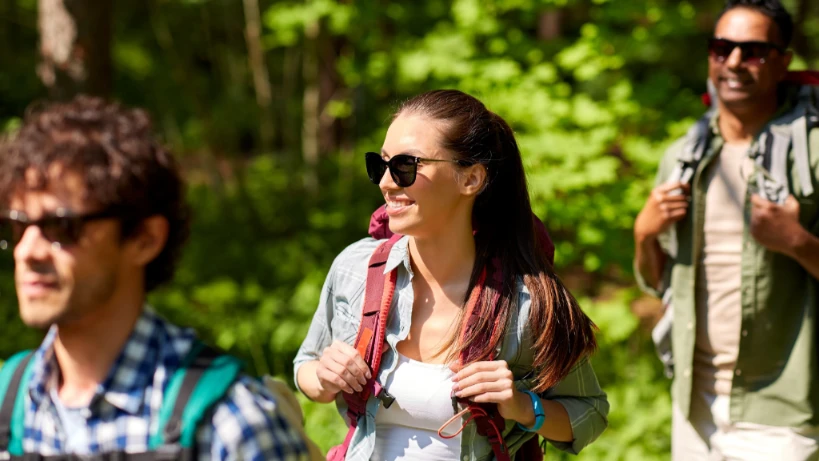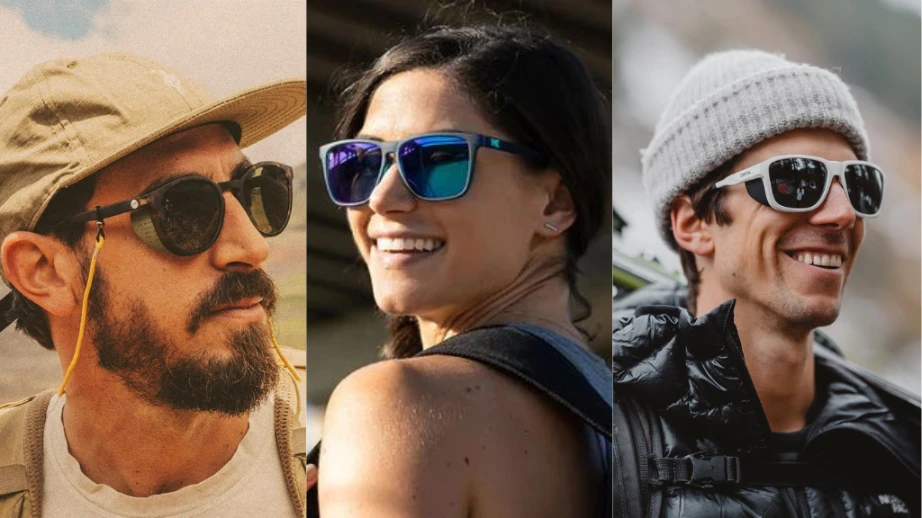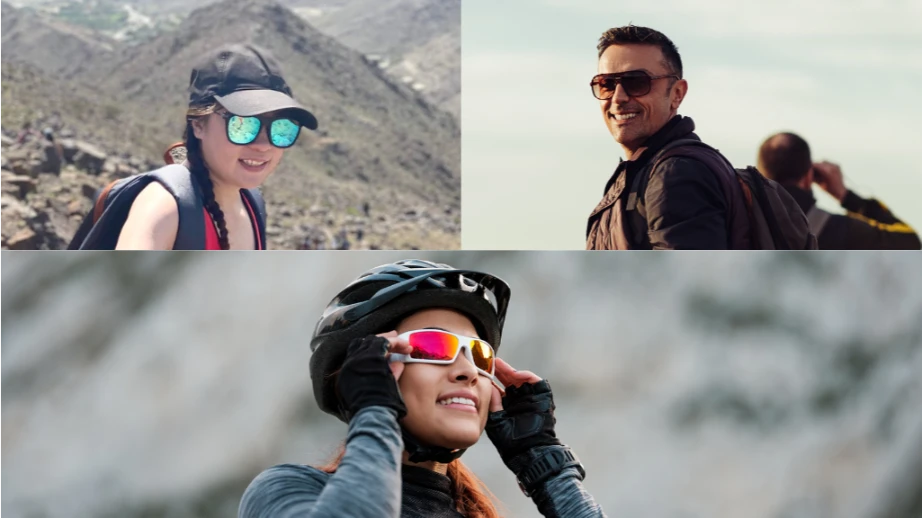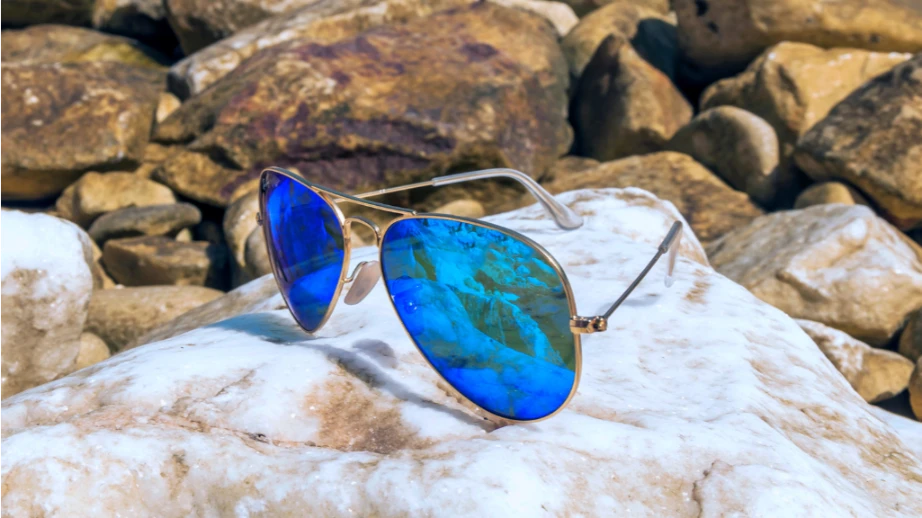In this guide, I’ll walk you through the 13 most critical features to look for before securing your next pair of hiking sunglasses. This number alone is a testament to the fact that, although compact, the right sunglasses will bring about a monumental difference on your hikes.
Picking the right pair goes way beyond just blocking out the glare. We’ll dive deep because when you’re on a trail, you want to make sure you’re not just protected, but also comfortable, and stylish too!
Why Do Hikers Wear Sunglasses?
Hikers consider sunglasses important because even on overcast days, the UV radiation can damage your skin and eyes and cause such conditions as pterygium or cataracts.
But that’s not the only reason. Sunglasses also help reduce glare and brightness, allowing you to see more clearly on bright, sunny days or while trekking through reflective surfaces like snow or water. They can also shield your eyes from dust, debris, and insects that may be flying around on the trail.
How to Choose Hiking Sunglasses?

The Critical Role of UV Protection
Did you know that 3.2 million people go blind annually due to UV exposure? These invisible rays from the sun can do a number on our eyes, leading to conditions like cataracts, macular degeneration, and even cancer. It doesn’t matter if it’s sunny or cloudy – UV rays are always there, ready to do their damage.
Importance of 99-100% UV Protection
When you’re out there, your eyes are exposed. That’s why choosing sunglasses offering 99-100% protection against both UVA and UVB rays is critical.
UVA and UVB are the two types of ultraviolet radiation we need to worry about. UVA rays penetrate deep into the eye, potentially harming the macula, a part of the retina responsible for our central vision.
On the other hand, UVB rays can damage the front part of the eye. So, when I say you need 99-100% protection, I mean it. Your eyesight is at stake.
But how can you be sure your sunglasses offer this level of protection?
Here’s a tip: look for labels or stickers on the glasses that clearly state “100% protection against UVA and UVB” or “UV400.” This means they block all light rays with wavelengths up to 400 nanometers, which includes both UVA and UVB.
Lens Material: Clarity and Durability
Your lenses not only have to protect your eyes from UV rays but also need to withstand all sorts of impacts.
The general consensus is that polycarbonate lenses are the best possible choice. They are 10 times more impact-resistant than their glass or plastic counterparts. It’s a lot! Whether you accidentally drop them while scaling a peak or they get hit by flying debris, chances are they’ll survive the ordeal and keep your eyes safe.

Polycarbonate lenses are also incredibly lightweight. Heavy sunglasses can become uncomfortable and cause fatigue, but with these lenses, you might even forget you’re wearing them. They’re that light.
While they’re not invincible, these lenses do hold up pretty well against scratches too, especially if they come with an additional protective coating.
Polarization: Enhancing Visibility
Have you ever been blinded by the glare bouncing off a lake or even a wet trail? It’s annoying and it can be downright dangerous. Polarized lenses are the remedy to this problem. They are especially useful for activities like hiking, fishing, boating, or driving.
Polarized sunglasses have a special coating that acts like a filter, blocking as much as 50% of light. They specifically target the light that reflects off surfaces like water, snow, and even paved roads.
Simply put, you get to enjoy a reduction in glare that can make a huge difference in how you experience your surroundings.
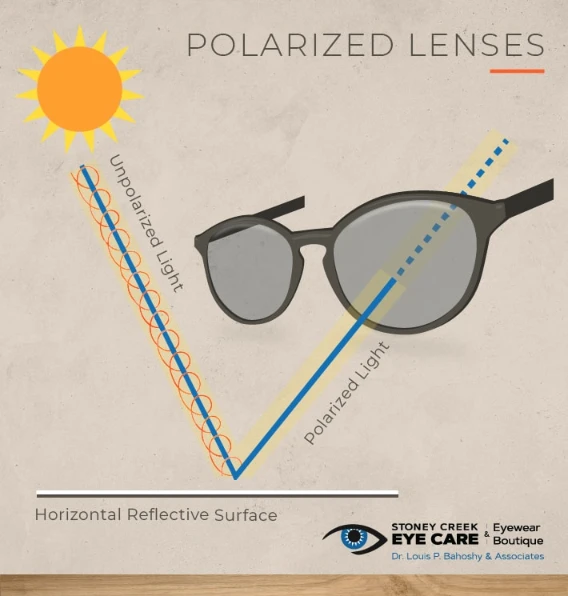
However, the benefits of polarization don’t stop at glare reduction. On a sunny day, these lenses can help improve contrast and visual clarity, making the greens of the trees and the blues of the sky pop like you wouldn’t believe. It’s like seeing the world in high definition.
Lens Tints and Colors
Amber and brown tints are the most popular choices among hikers. These tints can enhance contrast in forested or mountainous terrain by blocking blue light, improving depth perception and visual acuity.
With these tints, the greens of leaves and the browns of the earth pop with clarity, making every step a bit safer and more visually engaging.
Different tints serve different purposes:
- Gray tints are your go-to for reducing overall brightness without altering colors. Perfect for sunny days when you want to see the world in its true colors.
- Yellow or gold tints excel in low-light conditions. They brighten everything up, making them ideal for early morning hikes or cloudy days when you need that extra bit of visibility.
- Green tints strike a balance by reducing glare and enhancing shadows. They offer a good mix of contrast and color accuracy, making them versatile for various outdoor activities.
Frame Material and Fit
Let’s start with frame material. Plastic frames are lightweight and affordable, but they may not hold up well under intense outdoor use.
On the other hand, metal frames tend to be more durable and can withstand rough handling. However, they can be heavier and more expensive.
While plastic and metal frames are not the worst choices, I lean towards TR90 frames that you can find in higher-end sunglasses such as the Tifosi Swick Polarized Sunglasses.
TR90 brings together flexibility and durability like nothing else. They can bend without breaking and withstand all the drops, squashes, and tumbles that come with the hiking territory.
They’re also as light as a feather, so you’ll barely feel them on your face even after hours of hiking.
Adjustable Features for a Snug Fit
The fit is another crucial aspect. We’ve all been there: sunglasses that slide down your nose or hug too tight behind the ears. That’s why adjustable features like nose pads and temple grips are non-negotiable for hikers.
Adjustable nose pads let you customize the fit to your nose shape, ensuring your sunglasses stay put no matter how much you move. On a windy ridge or when you’re looking down to navigate, you’ll appreciate them for keeping everything in place.
Temple grips play a similar role but behind your ears. They make sure your sunglasses hug your head just right – not too tight, not too loose. Some are even made of materials that grip better when they get sweaty or wet, which is pretty much a given when you’re hiking.
Coverage and Design
Have you ever worn a pair of sunglasses and suddenly felt like you had a whole new perspective on everything around you? It’s all thanks to the wraparound design, with a curvature of 8-base or higher, which is curved more than a flat surface, mimicking the natural shape of your eye.
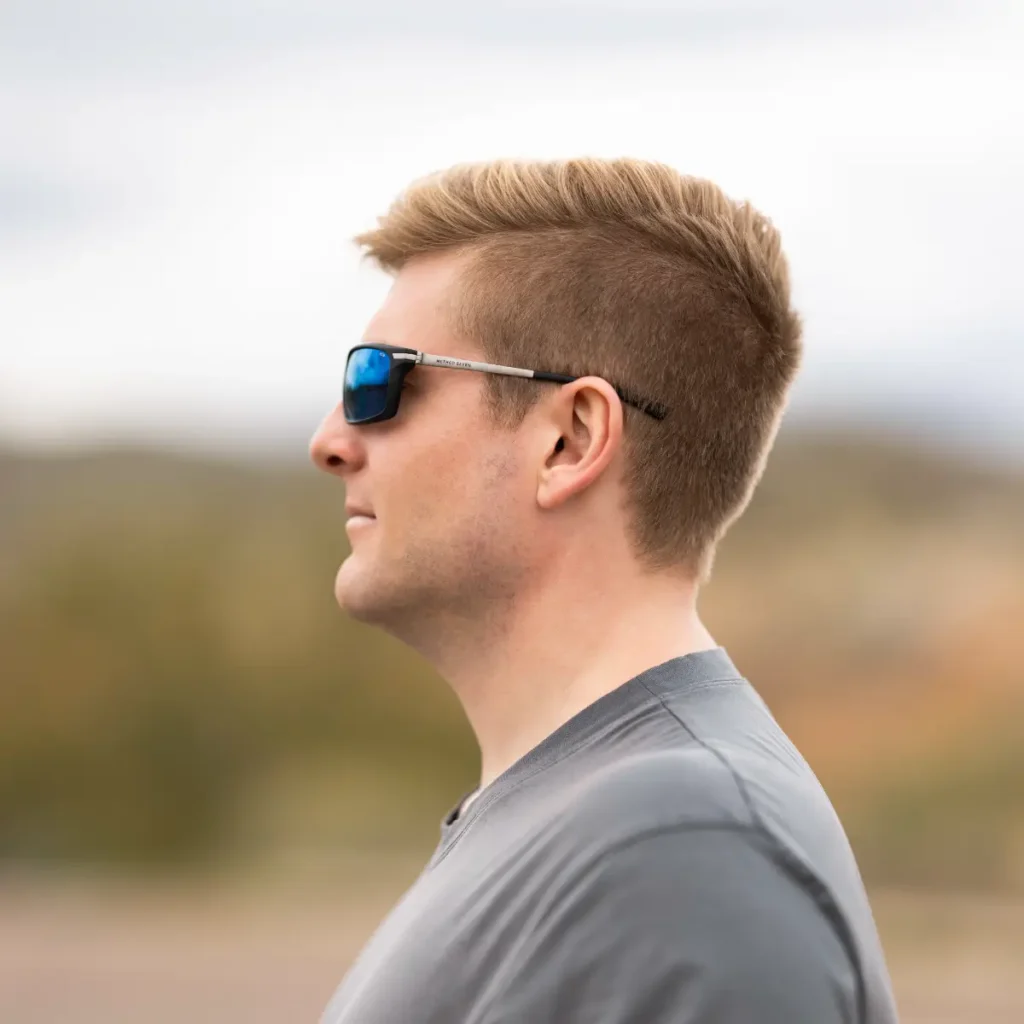
Wraparound sunglasses hug your face in a way that feels like they’re part of you. With this design, you get enhanced peripheral vision so you can see more of what’s beside you without having to turn your head.
Let’s say you’re hiking a narrow trail with steep drop-offs on one side. With wraparound sunglasses, you can keep your eyes straight ahead while still being aware of your surroundings. This is convenient and safe.
What’s more, this design offers superior protection from wind, dust, and the side rays of sunlight that seem to find their way into most other sunglasses. When you’re up on a ridge and the wind is howling, you’ll appreciate wraparound lenses for keeping your eyes tear-free.
Weight
When it comes to the weight of your sunglasses, aim for the sweet spot between 20 to 30 grams (that’s about 0.7 to 1 ounce). The perfect sunglasses should feel like you barely know they’re there. It’s about minimizing fatigue. Even the slight pressure of heavy sunglasses can add up over hours, leading to headaches and discomfort.
Versatility Through Interchangeable Lenses
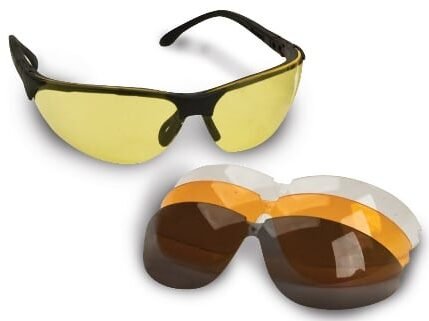
Interchangeable lenses are an amazing feature. It’s like having multiple pairs of sunglasses all wrapped up in one little package.
A good example here is the Sunski Tera Polarized Sunglasses, which tops our ranking of the most comfortable hiking sunglasses. They offer the flexibility to swap out lenses based on the light conditions you’re facing.
Starting your hike in the dim light of dawn? Pop in the clear lenses. As the sun climbs higher and starts beating down, switch to a darker tint to protect your eyes and improve your vision.
Proper vision on the trails can help you avoid obstacles and hazards, making your hike safer and more enjoyable. There’s also the undeniable cool factor of customizing your look on the go!
But how do you make the most of this versatility? Here are some quick tips:
- Know Your Environment: Before you set out, think about where you’ll be hiking. Dense forests may require lighter tints, while open areas with direct sunlight might call for darker shades.
- Practice Makes Perfect: Get familiar with changing your lenses at home before you hit the trails. The last thing you want is to be fumbling with your glasses when you should be enjoying the hike.
- Carry a Lens Case: To keep your spare lenses safe and scratch-free, invest in a small, lightweight lens case. It’s a small addition to your pack but a big step towards keeping your lenses in top condition.
Safety and Protection Features
First up, let’s discuss impact resistance. When you’re out on the trails, anything can happen. A low-hanging branch, a flying pebble, or even just a bad fall.
Ideally, your new sunglasses should provide the ANSI Z87.1 certification. It’s a standard that ensures your glasses can take a hit – whether it’s a high-mass impact like getting smacked by a fallen branch or a high-velocity one, like a ricocheting stone kicked up by your buddy hiking ahead.
This certification covers a range of hazards, including:
- Impact: Your glasses can withstand hits without breaking.
- Heat: They won’t melt or warp in high temperatures.
- Chemicals or Liquid Splash: No worries about splashes from streams or unexpected rain.
- Dust: Keeps those tiny particles out of your eyes.
- Radiation: Protection from harmful UV rays.
Although there are not many sunglasses that are ANSI certified, you can still spot some interesting options like the Heat Wave Visual Regulator Z87.
Water Resistance and Anti-fog Features
Keeping your vision clear, no matter the conditions, is equally important. Ever been hiking during an early morning when the dew is still fresh? Then you must know fogged-up glasses can be a problem.
That’s where hydrophobic coating and anti-fog technology come in handy. A hydrophobic coating repels water, making raindrops bead up and roll right off instead of smearing across your lenses.
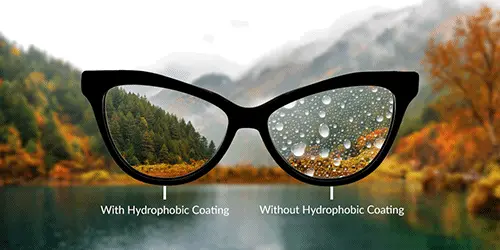
Meanwhile, anti-fog technology prevents annoying foggy patches that can obscure your vision at the worst possible times. With anti-fog coated lenses, you keep your vision sharp and unobstructed.
Brand Reputation and Warranty
Looking for the perfect pair of hiking sunglasses, there’s something just as important as the specs – and that’s brand reputation and warranty.
Warranty periods aren’t just numbers on a page. They’re a sign of how much faith a brand has in its product. Warranty periods can range from a modest one year to an impressive lifetime coverage. This is a big deal because it speaks volumes about the durability of the sunglasses and the confidence the brand has in its craftsmanship.
I’ve gone through brands that barely lasted a season and those that stuck with me through thick and thin. Two brands that really stood out for me are Knockaround and Smith.
Knockaround might not break your bank, but they still offer great value. And then there’s Smith renowned for their expensive but high-quality products. Their Smith Parallel 2 Max Polarized Sunglasses are my go-to choice for the most demanding hikes. They did set me back $155, but the quality, durability, and comfort they provide is unmatched.
Whether you choose the affordable reliability of Knockaround or the premium assurance of Smith, choose a brand that stands behind their product.
Compatibility with Other Gear
Whether you’re scaling a cliff or just taking a leisurely hike, chances are you’ll want some headgear to protect you from the sun or potential bumps. The last thing you want is for your sunglasses to become a nuisance when paired with hats and helmets. Here’s what you need to do:
- Check the arms of your sunglasses. They should be slim enough to fit comfortably under the straps of a helmet or the brim of a hat without causing pressure points.
- Try them on together before you hit the trails. It might look a bit funny trying on your full gear at home, but it’s better than discovering issues when you’re miles away from comfort.
If you wear glasses, you know the struggle of finding sunglasses that work with your prescription. But there are options out there for you:
- Look for sunglasses that offer prescription inserts. These allow you to have your prescription lenses fitted directly into your sunglasses. No more choosing between clear vision and protecting your eyes from the sun.
- Consider clip-ons or over-glasses sunglasses. If inserts aren’t your thing, there are sunglasses designed to fit right over your regular glasses. They might not be the most stylish option, but they get the job done.
Customer Reviews and Recommendations
There’s no substitute for real-life experience. When it comes to hiking sunglasses, the feedback from those who’ve already hit the trails with them can be invaluable.
First off, aim for products with an average rating of 4 stars or above. Sunglasses with this rating have consistently met or exceeded hikers’ expectations.
Platforms like REI or Backcountry are treasure troves of such information. They’re frequented by serious outdoor buffs who know their stuff. They won’t sugarcoat their experiences, which is exactly what you need.
But you shouldn’t just glance at the stars. Dive into the reviews. Look for those written by folks who share your needs. Are you into high-altitude trekking? Search for reviews from mountaineers. Prefer forest trails? Look for woodland wanderers.
Pay attention to the specifics. If someone says a pair of sunglasses was great, find out why. Was it the durability? The way they didn’t fog up during a sweaty climb? Or maybe it was the clarity of vision they provided across various light conditions. These details matter because they match up to real situations you might find yourself in.
Don’t forget to check if the reviewer mentions any downsides. Even the highest-rated gear has its flaws, and knowing these can help you weigh the pros and cons better. Maybe those sunglasses that are perfect for desert hikes fall short in humid, misty environments.
Price vs. Quality: Finding the Balance
The price tags can swing wildly from a modest $20 to even $300 or more. From my experience of hunting for an ideal pair, it’s wise to start considering options around the $50 mark. At this price point, you start to see the essentials that make a pair of sunglasses great for hiking.
But sometimes, you don’t even have to spend this much to find a perfect pair. For example, goodr OGs Polarized Sunglasses are priced at just $25, yet they served me well over the years. They tick all the boxes: durable, comfortable, polarized, and affordable. They’ve even earned a spot in our ranking of the best sunglasses for hiking!
So, what’s the catch? The truth is, there isn’t one. It just goes to show that sometimes, you stumble upon a gem that proves price isn’t the ultimate indicator of quality.
Conclusion
Choosing the right pair of sunglasses for hiking isn’t as straightforward as picking out a new pair of pants or even boots as there’s a lot more features to consider.
By now, you’re probably armed with a checklist of features longer than your hiking stick. From UV protection and polarization to frame durability and lens color, it’s a bit like assembling your dream trail mix where every ingredient matters.
But one thing is crystal clear – you absolutely need a good pair of sunglasses for hiking. Don’t rush the process, and most importantly, trust your instincts. If a pair feels right, fits well, and ticks off all essential features, you’re probably on to a winner.

Lukas Heller
Hey there! I’m Lukas, co-founder of BigfootHiking.com, alongside my adventurous wife Martha. Originally from Germany, I landed in Phoenix, Arizona, in 2015, where I’ve been scouting out new trails ever since (though they’re getting scarce!). By day, I’m a software developer, but my heart belongs to hiking – I’m always plotting our next trip. When I’m not coding or on the trails, you’ll find me hanging out with our Pit Bull, Zeus.

